‘How to write a brilliant brief’
Here’s an interview with Lesya Lysyj, former CMO of Heineken USA, where she tells clients how to create better briefs.
Her five points are:
First is Know Thy Brand – if you’re selling an emotional product, such as beer, you need to have emotion at your core. Rational products, such as gum, need a rational benefit.
Is chewing gum really a ‘rational’ product? I remember this ad from when I was at school:
All emotion, nothing rational. It seemed to sell a lot of gum. In fact, I can’t recall a single rational gum ad. Surely the ‘rational’ benefits of gum are all subjective (flavour etc.), while longevity is a function of how quickly you get used to the flavour (this is why you can take your flavourless gum our of your mouth, leave it somewhere, then start chewing it again to discover the flavour has returned). Anyway, on the brief side of things, ‘do a brief that matches the emotional/rational level of the product’ makes good sense and is fine advice if you’re so thick this thought has never occurred to you before.
Next is Don’t Get Bored With A Great Brief. She changed a brief because sales were declining. This messed things up even more, so she returned to a version of the original brief and sales picked up again. Great, but her original brief clearly seemed to be something other than ‘great’, hence the falling sales. If everyone had thought it was still ‘great’ they wouldn’t have changed it. So she’s really saying, ‘Don’t fail to recognise a great brief’, which again seems both obvious and a bit of a tricky ask.
Then we have Every Word Counts. This is illustrated by an example where calling out ‘bollocks in beer’ was changed to the wider canvas of calling out mere ‘bollocks’, allowing for a bigger idea. I suppose that’s a good point, but I think it comes down to ‘write a good brief that allows lots of good work; not a shit one that doesn’t’, and again that’s a bit obvious. It’s not just the words that changed in her example; it’s the whole scope of the idea. When you change words you change the brief, but you still need the smarts to think of the better brief.
The next one says How Much Creative Is Actually Needed? But it’s not really about that, so much as suggesting you divvy up your media budget up front for some reason that seems less and less clear to me the more I read her paragraph. Sorry, but I can’t really work out what she’s on about, let alone how it relates to the amount of creative needed.
The final one is Mandatories. She says that this laundry list of things to include in the advertising can kill the final work, so don’t have more than three. I’d say that it’s not the number of mandatories that matters but the nature of them. One mandatory that says ‘feature a squawking, shitting monkey throughout the spot’ will do more damage than ten that say things like ‘Don’t feature junk food’ or ‘include a shot of the new pack’.
She signs off with this:
Good luck. As I have said before, this whole thing is incredibly difficult. Like raising kids, most of the time you are wondering if you’re doing the right thing and just hoping for the best. And you won’t know if you made the right decisions until they end up being a Rhodes Scholar or going to prison. The best you can do is follow your instincts, trust your planner, and don’t be afraid to adjust along the way.
That’s more interesting, because when a brief finally arrives on the desk of the creative team it often seems like it’s taken a long time and (supposedly) a lot of effort to produce something that can be uninspiring or break down easily under scrutiny. I guess a brief that doesn’t do that is hard to come by, hence the ‘incredibly difficult’ part of what she says. But because a brief is a single piece of paper that has sometimes taken months to produce (sometimes leaving a few days for the creatives to answer it) the feeling is that it had better bloody well be good when it arrives. I don’t think many creatives have a clear sense of what has gone into the process, and our ‘natural’ sense of grumpy, come-on-then-impress-me cynicism means that we’re rarely blown away when we read one.
And when you read articles like that you wonder how many of them across the industry really are just poor.

